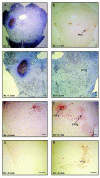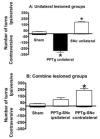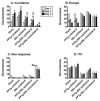Functional disconnection of the substantia nigra pars compacta from the pedunculopontine nucleus impairs learning of a conditioned avoidance task
- PMID: 20595069
- PMCID: PMC4291837
- DOI: 10.1016/j.nlm.2010.05.011
Functional disconnection of the substantia nigra pars compacta from the pedunculopontine nucleus impairs learning of a conditioned avoidance task
Abstract
The pedunculopontine tegmental nucleus (PPTg) targets nuclei in the basal ganglia, including the substantia nigra pars compacta (SNc), in which neuronal loss occurs in Parkinson's disease, a condition in which patients show cognitive as well as motor disturbances. Partial loss and functional abnormalities of neurons in the PPTg are also associated with Parkinson's disease. We hypothesized that the interaction of PPTg and SNc might be important for cognitive impairments and so investigated whether disrupting the connections between the PPTg and SNc impaired learning of a conditioned avoidance response (CAR) by male Wistar rats. The following groups were tested: PPTg unilateral; SNc unilateral; PPTg-SNc ipsilateral (ipsilateral lesions in PPTg and SNc); PPTg-SNc contralateral (contralateral lesions in PPTg and SNc); sham lesions (of each type). SNc lesions were made with 1-methyl-4-phenyl-1,2,3,6-tetrahydropyridine HCl (MPTP, 0.6micromol); PPTg lesions with ibotenate (24nmol). After recovery, all rats underwent 50-trial sessions of 2-way active avoidance conditioning for 3 consecutive days. Rats with unilateral lesions in PPTg or SNc learnt this, however rats with contralateral (but not ipsilateral) combined lesions in both structures presented no sign of learning. This effect was not likely to be due to sensorimotor impairment because lesions did not affect reaction time to the tone or footshock during conditioning. However, an increased number of non-responses were observed in the rats with contralateral lesions. The results support the hypothesis that a functional interaction between PPTg and SNc is needed for CAR learning and performance.
Copyright 2010 Elsevier Inc. All rights reserved.
Figures







References
-
- Aguilar MA, Mari-Sanmillan MI, Morant-Deusa JJ, Minarro J. Different inhibition of conditioned avoidance response by clozapine and DA D-1 and D-2 antagonists in male mice. Behavioral Neuroscience. 2000;114:389–400. - PubMed
-
- Alderson HL, Winn P. The pedunculopontine and reinforcement. Springer; New York: 2005.
-
- Alderson HL, Brown VJ, Latimer MP, Brasted PJ, Robertson AH, Winn P. Excitotoxic lesions of the pedunculopontine tegmental nucleus in rats: an examination of the perception of reward strength measured by responding on a progressive ratio schedule of reinforcement. Neuroscience. 2002;112:417–425. - PubMed
-
- Alderson HL, Latimer MP, Blaha CD, Phillips AG, Winn P. An examination of d-amphetamine self-administration in pedunculopontine tegmental nucleus-lesioned rats. Neuroscience. 2004;125:349–358. - PubMed
-
- Alexander GE, Delong MR, Strick PL. Parallel organization of functionally segregated circuits linking basal ganglia and cortex. Annual Review of Neuroscience. 1986;9:357–381. - PubMed
Publication types
MeSH terms
Substances
Grants and funding
LinkOut - more resources
Full Text Sources
Miscellaneous

